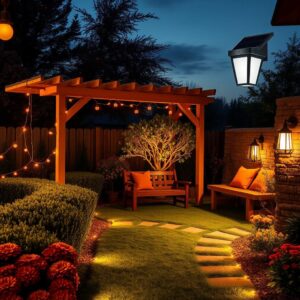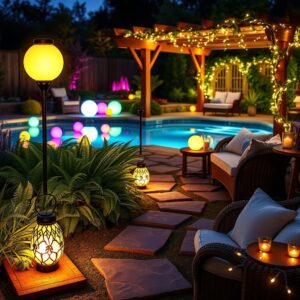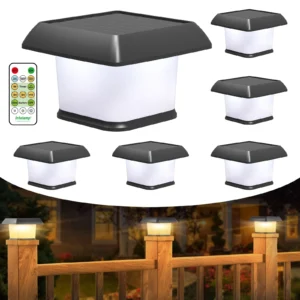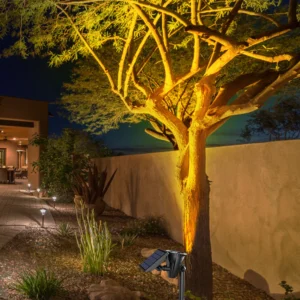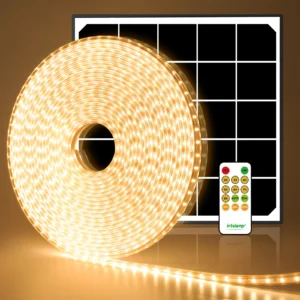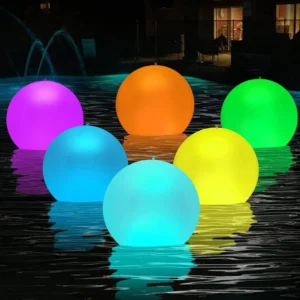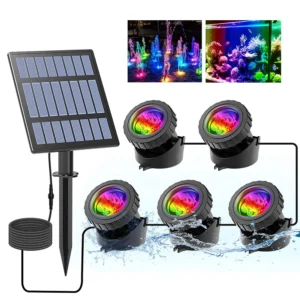Solar string lights create a warm and inviting atmosphere in any outdoor space, but they can sometimes face technical difficulties. This guide will explore common problems and their solutions, helping you keep your solar string lights shining brightly.
1. Bulbs Burned Out
Burned-out bulbs are one of the most common issues encountered with solar string lights, and understanding the causes can help prevent future problems. The primary reasons for bulb burnout include regular wear and tear, exposure to extreme weather conditions, or improper installation. Additionally, using bulbs that are not compatible with your solar string lights can lead to premature failure.
To address this issue, follow these replacement steps:
Identify the Burned-Out Bulb: Inspect your string lights carefully. A burned-out bulb may appear dark or have a broken filament. If you notice that the entire string is off, it may be a sign that one or more bulbs need attention.
Remove the Faulty Bulb: Depending on the design of your string lights, removing a burned-out bulb may involve unscrewing it or simply pulling it out of the socket. Handle the bulb gently to avoid breaking it.
Choose a Compatible Replacement: When selecting a new bulb, ensure it matches the wattage and type specified for your solar string lights. Using the correct bulb type—such as LED or incandescent—will optimize performance and lifespan.
Install the New Bulb: Insert the new bulb into the socket securely, ensuring it fits snugly but is not overtightened. For screw-in bulbs, turn it gently until it’s firmly in place.
Test the Lights: Once the new bulb is installed, test your solar string lights by turning them on. If they don’t illuminate, double-check all connections and ensure the solar panel is receiving adequate sunlight.
Prevent Future Burnouts: To extend the lifespan of your bulbs, store them carefully during off-seasons, handle them gently during installation, and consider using bulbs designed for outdoor use to resist weather-related wear.
2. Contacts Rusted
Rusty contacts can significantly hinder the performance of your solar string lights by disrupting the electrical connections between the bulbs and sockets. This issue is often caused by exposure to moisture, dirt, or environmental elements, leading to oxidation and corrosion. Regular maintenance can help prevent rust buildup, but when it occurs, cleaning the contacts is essential.
Steps to Clean Rusted Contacts:
Safety First: Before you begin, ensure that the solar string lights are turned off and disconnected from any power source. This will help avoid electrical shocks and damage during the cleaning process.
Gather Your Supplies: You will need a contact cleaner specifically designed for electrical components, a soft cloth or paper towels, and possibly a small brush or cotton swabs for detailed cleaning.
Locate the Affected Contacts: Inspect each bulb and socket closely to identify rusted or corroded areas. Look for discoloration, flaky residue, or any visible signs of oxidation.
Apply the Contact Cleaner: Spray a small amount of contact cleaner directly onto the rusted contacts. Be cautious not to saturate the area excessively, as you only need a light application to dissolve the rust.
Clean the Contacts: Using a soft cloth, paper towel, or a small brush, gently scrub the rusted areas. If you’re using cotton swabs, dip them in the cleaner and carefully wipe the contacts to remove oxidation. Repeat this step as necessary until the contacts appear clean and shiny.
Dry the Area: Allow the cleaned contacts to dry completely before reassembling the lights. This is crucial to prevent any moisture from being trapped, which could lead to further rusting.
Reassemble and Test: Once the contacts are clean and dry, reinsert the bulbs into their sockets. Test the lights to ensure they are functioning properly. If the lights are still not working, double-check all connections and inspect for other potential issues.
Prevent Future Rusting: To minimize the chances of rust returning, regularly clean the contacts, store the lights in a dry place, and consider using a protective spray designed to resist moisture. Keeping the lights away from direct exposure to rain or high humidity will also help.
3. Damaged Wire
Damaged wires are a common issue that can cause your solar string lights to fail. These problems often arise from physical stress, such as pulling, twisting, or bending the wires too harshly. Understanding how to identify and repair damaged wires can help restore your lights and prevent future issues.
Steps to Identify and Repair Wire Damage:
Safety Precautions: Before inspecting or repairing the wires, ensure that the solar string lights are turned off and disconnected from any power source. This will help prevent electric shock and protect your tools and hands during the process.
Visual Inspection: Carefully examine the entire length of the wire for any signs of damage. Look for fraying, cuts, or exposed inner wires. Pay special attention to areas that may have been subjected to stress, such as tight bends or points where the wire may have been pinched or pulled.
Perform a Flex Test: Gently bend and flex the wire in various areas. If you hear crackling sounds or see flickering lights while doing this, it could indicate a break or weak point in the wire that needs attention.
Locate the Damage: Once you identify a damaged section, mark it for easy reference. If the damage is not visible, you may need to strip the wire insulation in that area to assess the condition of the internal wiring.
Gather Repair Tools: For repairs, you will need wire strippers, wire connectors (such as butt connectors), electrical tape, and possibly a soldering iron if you prefer a more permanent solution.
Cut Out the Damaged Section: Using wire cutters, carefully remove the damaged segment of wire. Ensure that you cut a bit beyond the visible damage to eliminate any potential weak points.
Strip the Wire Ends: Use wire strippers to remove about half an inch of insulation from both ends of the remaining wire. Be careful not to damage the wire itself while stripping.
Join the Wires: Depending on your chosen method, you can either twist the ends of the wire together and cover them with electrical tape or use wire connectors. If using connectors, insert the stripped ends into the connector and crimp it securely.
Soldering Option: For a more durable repair, consider soldering the wire ends together. Heat the soldering iron, apply solder to the twisted wires, and allow it to cool. Once cooled, cover the joint with electrical tape for added insulation.
Test the Repair: Reconnect the lights to the power source and test them to ensure they are functioning properly. If they do not work, double-check your connections and inspect for any additional damage.
Prevent Future Damage: To reduce the risk of future wire damage, handle the lights carefully during installation and storage. Avoid excessive bending or pulling, and consider using protective covers for outdoor installations to shield the wires from environmental stressors.
4. Loose Bulb
Loose bulbs are a frequent cause of malfunction in solar string lights, leading to flickering or complete failure of the affected section. Understanding how to secure loose bulbs can help maintain the overall integrity of your lighting display, ensuring a bright and consistent glow.
Steps to Secure Loose Bulbs:
Safety First: Before addressing any loose bulbs, ensure the solar string lights are turned off and disconnected from their power source. This will prevent any electrical hazards and protect the bulbs from damage during the process.
Visual Inspection: Examine each bulb to identify which ones are loose. A loose bulb may appear slightly out of its socket or wobble when touched. Gently press on the bulb to see if it moves more than it should.
Gather Your Tools: For this task, you typically won’t need many tools. However, having a soft cloth or gloves on hand can help protect your hands while handling the bulbs, especially if they are hot.
Remove the Loose Bulb: Carefully twist the loose bulb counterclockwise to remove it from its socket. If the bulb is stubborn, gently wiggle it while turning. Take care not to apply excessive force, as this could break the bulb or damage the socket.
Inspect the Socket: Once the bulb is removed, inspect the socket for any signs of dirt, corrosion, or damage. Clean the socket with a soft cloth to remove any debris that might interfere with the bulb’s connection.
Secure the Bulb: Before reinserting the bulb, check the base for any signs of wear. If the bulb is designed to fit securely, simply align it with the socket and twist it clockwise until it is firmly seated. Ensure that it is snug but avoid overtightening, which could crack the bulb or break the socket.
Use Electrical Tape (if needed): For additional security, especially in windy or outdoor conditions, consider using a small piece of electrical tape to help hold the bulb in place. Wrap it gently around the base of the bulb and the socket, ensuring it doesn’t cover any ventilation holes.
Check Surrounding Bulbs: While you’re at it, check nearby bulbs for looseness as well. It’s a good idea to ensure that all bulbs are securely fastened to prevent future issues.
Test the Lights: After securing the bulb, reconnect the lights to their power source and turn them on to ensure they are functioning correctly. Observe the newly secured bulb to confirm it stays lit and does not flicker.
Prevent Future Loose Bulbs: To minimize the chances of bulbs becoming loose again, handle the string lights with care during installation and storage. Avoid placing them in areas where they may be subject to strong winds or accidental bumps.
5. Tripped Circuit Breaker
A tripped circuit breaker can prevent your solar string lights from functioning, often due to an electrical overload or a short circuit. Knowing how to reset a tripped breaker safely is essential for restoring power and ensuring the continued performance of your lighting.
Steps to Reset a Tripped Circuit Breaker:
Safety Precautions: Before proceeding, make sure to turn off your solar string lights and any other devices connected to the same circuit. This will help prevent further overload when you reset the breaker.
Locate the Circuit Breaker Panel: Find your circuit breaker panel, usually located in a basement, garage, or utility room. It may be behind a door or a small access panel.
Inspect the Breaker Panel: Open the panel and look for any breakers that are in the “off” position or that have moved to a tripped position (often indicated by the switch being halfway between on and off). Tripped breakers typically have a red or yellow indicator.
Identify the Tripped Breaker: If there are multiple breakers, identify the one corresponding to the area where your solar string lights are installed. It may be labeled for convenience, indicating which circuits it controls.
Resetting the Breaker: Firmly push the tripped breaker switch all the way to the “off” position first. Then, push it back to the “on” position. You should feel a click when it resets. This action helps clear any faults and re-establishes the electrical connection.
Check for Overloads: If the breaker trips again after being reset, it could indicate an overload or a short circuit. Disconnect any devices that were connected to that circuit, including your solar string lights, and try resetting the breaker again.
Test the Lights: After resetting the breaker, reconnect your solar string lights and turn them on. Observe to see if they illuminate without issue. If they work, you’ve successfully restored power.
Monitor the Situation: Keep an eye on the circuit in the following days. If the breaker trips repeatedly, it may indicate an underlying electrical problem that requires further investigation.
Seek Professional Help: If you are uncomfortable working with electrical systems or if the breaker continues to trip, it’s essential to consult a licensed electrician. They can assess the situation and provide a thorough inspection to identify and resolve any electrical issues safely.
Prevent Future Tripping: To minimize the risk of future tripped breakers, avoid overloading circuits with too many devices. Consider redistributing your electrical load across multiple circuits and using energy-efficient appliances. Additionally, ensure your solar string lights are suitable for outdoor use and comply with their electrical specifications.
6. Frayed Extension Cord
A frayed extension cord can pose a significant safety risk, potentially leading to electrical shorts or fires. If you notice any damage to your extension cord used for solar string lights, it’s essential to replace it promptly to ensure safe and effective operation.
Steps to Replace Damaged Extension Cords:
Assess the Damage: Before replacing an extension cord, inspect it thoroughly. Look for signs of fraying, exposed wires, or burn marks. If any part of the cord appears damaged, it’s safer to replace it entirely rather than attempting to repair it.
Disconnect Power: Ensure that the damaged extension cord is unplugged from both the power source and the solar string lights. This will prevent any risk of electric shock while you work on the replacement.
Choose the Right Replacement: When selecting a new extension cord, consider the following:
- Length: Choose a cord that is long enough to reach from your power source to the desired location for your solar lights without being excessively long.
- Rating: Ensure the replacement cord is rated for outdoor use if the lights will be outside. Look for cords marked as “heavy-duty” or “weather-resistant” for added durability.
- Gauge: Opt for a lower gauge number (like 12 or 14 gauge) for high-wattage devices, as these cords can handle more power without overheating.
Gather Necessary Tools: You typically won’t need many tools for this task, but having pliers or a flathead screwdriver on hand can be helpful, especially if the damaged cord is attached to any fixtures.
Remove the Damaged Cord: If the frayed extension cord is connected to any fixtures or junctions, carefully disconnect it. Ensure you follow the correct procedures to avoid damaging any associated equipment.
Install the New Cord: Take your new extension cord and plug it into the power source. If your lights are also attached to any fixtures, connect the new cord securely. Make sure all connections are tight and that the cord is inserted fully into sockets.
Secure the Cord: To prevent future damage, consider using cord clips or ties to secure the extension cord along walls, decks, or pathways. This will help keep the cord off the ground and protected from potential hazards, such as foot traffic or water exposure.
Test the Setup: Once everything is connected, turn on your solar string lights to ensure they operate correctly. Check for any flickering or issues, which may indicate a connection problem.
Regular Inspections: To maintain safety, periodically inspect your extension cords for signs of wear or damage. Make it a habit to check them before each use, especially if they’ve been exposed to the elements.
Store Cords Properly: When not in use, store your extension cords in a cool, dry place away from direct sunlight or moisture. Proper storage will help extend the lifespan of your cords and prevent deterioration.
7. Animal Damage
Animal damage to your solar string lights can be a frustrating issue, especially if you live in areas where wildlife is prevalent. Animals like squirrels, mice, and birds may chew through wires, leading to electrical shorts and malfunctioning lights. Addressing this damage promptly is crucial to restore functionality and prevent further issues.
Steps to Address Animal Damage:
Identify the Damage: Inspect your solar string lights thoroughly for any signs of animal interference. Look for chewed wires, frayed insulation, or disconnected components. Take note of the extent of the damage to determine if repairs can be made or if the entire unit needs replacement.
Ensure Safety: Before you begin any repairs, disconnect the solar lights from the power source. This is essential to avoid electric shock and to protect yourself while handling damaged components.
Remove Affected Lights: If animal damage is concentrated in specific sections, carefully remove those affected lights from the string. You may need wire cutters or pliers to disconnect the damaged sections.
Assess Repair Options:
- For Minor Damage: If only a small section of wire is chewed, you may be able to repair it using wire connectors and electrical tape. Cut out the damaged portion, strip the ends of the remaining wire, and connect them securely with connectors. Then wrap the connections with electrical tape to provide insulation and protection.
- For Extensive Damage: If the damage is extensive or affects multiple bulbs, it may be more effective to replace the entire string of lights. Purchasing a new set designed for outdoor use can ensure durability against wildlife.
Install New Lights: If replacing damaged lights, follow the manufacturer’s instructions to install the new solar string lights. Ensure all connections are secure and that the lights are appropriately mounted or hung.
Implement Preventative Measures: To reduce the likelihood of future animal damage, consider the following strategies:
- Protective Covers: Use animal-proof covers or enclosures for your solar lights. These can deter animals from accessing the wires and bulbs.
- Strategic Placement: Position your solar string lights in areas less accessible to wildlife, such as higher up or in enclosed spaces like patios or porches.
- Repellent Sprays: Consider using non-toxic animal repellents around the perimeter of your lights. These products can deter animals from approaching without harming them.
Regular Monitoring: Keep an eye on your solar lights to check for any signs of renewed animal activity. Early detection of potential issues can save you from more extensive repairs down the line.
Educate Neighbors: If you live in a community with similar wildlife issues, share your experiences and solutions with neighbors. Collective efforts to deter animals can help protect everyone’s outdoor lighting.
Consult Professionals: If animal damage persists despite your best efforts, it may be worth consulting with pest control experts. They can provide insights on how to manage local wildlife populations and protect your property.
Stay Informed: Research the types of wildlife common in your area and understand their behaviors. Knowing when they are most active can help you take preventative measures, such as bringing in lights during peak seasons.
8. Water Damage
Water damage is a common issue for solar string lights, especially those used outdoors, as they may be exposed to rain, snow, or high humidity. Moisture can cause electrical shorts, corrosion, and ultimately lead to malfunctioning lights. Addressing water damage promptly is essential to restore functionality and prevent further issues.
Steps to Dry Out Water-Damaged Lights:
Safety First: Before attempting any repairs, disconnect the solar lights from the power source to ensure your safety. This step is critical to avoid electrical shock and protect yourself while handling wet components.
Assess the Damage: Inspect the lights for signs of water damage. Look for moisture in the bulbs, sockets, and wiring. If you notice any corrosion on the contacts, this may require additional cleaning to restore functionality.
Remove the Lights: Carefully detach the water-damaged lights from their installation. This may involve unscrewing bulbs or disconnecting wires. Handle the components gently to avoid further damage.
Drying Process:
- Air Drying: Place the lights in a dry, well-ventilated area to allow natural air circulation. Lay the lights flat or hang them up to promote drying. Depending on the extent of moisture, this method may take several hours to a few days.
- Use of Towels: If there is excess water, use absorbent towels to gently blot and soak up moisture from the bulbs and wires. Avoid rubbing, as this can damage the components.
- Heat Sources: For faster drying, you can use a hairdryer on a low, cool setting or a fan to circulate air around the lights. Ensure that the heat is not too intense, as this could damage plastic components.
Inspect After Drying: Once the lights are thoroughly dried, check for any remaining moisture or signs of corrosion. Pay special attention to the connections and contacts. If you notice any rust, it may need cleaning with a contact cleaner designed for electrical components.
Reconnect and Test: Once you’re confident that the lights are completely dry and free of corrosion, reconnect them to the power source. Test the lights to see if they function properly. If they do not light up, further troubleshooting may be necessary, such as checking for damaged wires or bulbs.
Prevent Future Water Damage:
- Choose Waterproof Options: When replacing lights, consider investing in solar string lights specifically designed for outdoor use with waterproof ratings. These lights are better equipped to handle moisture exposure.
- Proper Installation: Install lights in a way that minimizes their exposure to water, such as avoiding low-lying areas prone to pooling or flooding.
- Seasonal Care: During harsh weather conditions, consider bringing the lights indoors or using covers to protect them from the elements.
- Regular Maintenance: Periodically check your outdoor lights for any signs of wear or potential water damage. Early detection can help mitigate issues before they become severe.
Consider Professional Help: If your lights suffer extensive water damage or if you’re unsure about the repair process, it may be wise to consult with a professional electrician. They can assess the condition of the lights and provide guidance on repair or replacement.
Keep Documentation: Maintain a record of any repairs or replacements you perform on your solar string lights. This can help you track issues over time and inform your decisions when selecting future lighting options.
9. Circuit Overloaded
An overloaded circuit occurs when too many devices draw power from a single electrical circuit, causing it to exceed its safe limit. This can lead to tripped circuit breakers, flickering lights, or even electrical fires. Properly managing your load is crucial for the safety and functionality of your solar string lights and other connected devices.
Steps to Manage Circuit Load:
Understand Circuit Ratings: Each circuit in your home is rated for a specific amperage, typically 15 or 20 amps. Familiarize yourself with the rating of the circuit that powers your solar string lights. This information is usually found on the circuit breaker itself.
Calculate Power Needs: Assess the total wattage of all devices connected to the circuit. Add up the wattage of each light bulb, appliance, or electronic device. Use the formula:
Total Wattage=Number of Bulbs×Wattage per Bulb\text{Total Wattage} = \text{Number of Bulbs} \times \text{Wattage per Bulb}Total Wattage=Number of Bulbs×Wattage per BulbEnsure that the total does not exceed 80% of the circuit’s capacity to avoid overload.
Prioritize Devices: If the circuit is frequently overloaded, prioritize essential devices and consider unplugging non-essential ones. This helps reduce the load and minimizes the risk of tripping the breaker.
Distribute the Load: Spread out your devices across multiple circuits. If possible, plug your solar string lights into a different circuit than other high-wattage appliances. This can help balance the load and reduce strain on any single circuit.
Use Power Strips Wisely: When using power strips, avoid daisy-chaining multiple strips together, as this can create excessive load and increase the risk of overheating. Choose power strips with built-in surge protection and circuit breakers to enhance safety.
Monitor Circuit Breakers: Regularly check your circuit breakers for signs of wear or malfunction. If a breaker frequently trips, it may indicate that the circuit is overloaded or that there’s a deeper electrical issue. In such cases, consult an electrician for a professional assessment.
Upgrade Electrical Capacity: If you consistently find yourself struggling with overloaded circuits, consider upgrading your electrical system. This could involve adding dedicated circuits for high-wattage devices or increasing the overall amperage of your home’s electrical service.
Implement Smart Technology: Consider using smart plugs or timers to manage the usage of your solar string lights. These devices can help you set schedules, turn lights on and off remotely, and monitor energy consumption, allowing for better load management.
Educate Household Members: Ensure everyone in your household understands the importance of not overloading circuits. Provide guidance on which devices can safely share outlets and the signs of an overloaded circuit.
Plan for Future Additions: If you’re considering adding more lighting or devices in the future, evaluate your current circuit capacity. Planning ahead can help prevent overloads and ensure that your electrical system remains safe and efficient.


